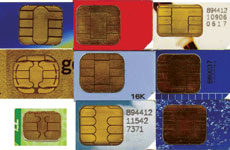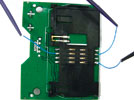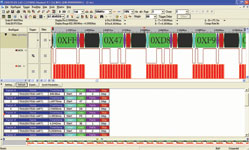

A smartcard, chip card, or integrated circuit card (ICC), is any pocket-sized card with embedded integrated circuits which can process data.
This implies that it can receive input which is processed – by way of the ICC applications – and delivered as an output.
There are two broad categories of ICCs: memory cards contain only non-volatile memory storage components and perhaps some specific security logic, while microprocessor cards contain volatile memory and microprocessor components. The card is made of plastic, generally PVC, but sometimes ABS. It may embed a hologram to avoid counterfeiting.

Using smartcards is also a form of strong security authentication for single sign-on within large companies and organisations.
Table 1 describes the contacts of a smartcard and Figure 2 shows a typical smartcard reader which is sold on the market.
Measurement of ISO 7816 signals with a logic analyser

There are eight contacts on the smartcard in total. It is necessary to connect only three of them (clock, ground and I/O) to the Zeroplus logic analyser when measuring. All Zeroplus logic analysers come with 30 to 60 free protocol interpreters; one of these is the ISO 7816 protocol for communicating with smartcards. The captured waveform on a Zeroplus LA is displayed in Figure 3.
The signal structure of ISO 7816 is similar to that of RS-232C, the difference being that ISO 7816 relies on the clock to synchronise the data while RS-232C uses the baud rate of its signal to synchronise the data. ISO 7816 takes the 16 bits of clock as one unit to start sampling data – see Figure 4.

As shown in Figure 5, after the clock signal after the start bit has generated 16 cycles (1 ETU), it is time to look for the data; the data packet is analysed in the same way.

The format of the signal packet consists of the Start (1 bit), Data (8 bits), Parity Check (1 bit) and Stop (2 bits). Each bit on the data line needs to appear for 16 clock cycles (1 ETU) on the clock line, and the transmission direction of the data is fixed, which is LSB to MSB.
Setting up any protocol interpreters for the Zeroplus LA is made very simple by an intuitive user interface and context-specific menus. Only four properties in two categories need to be specified:
Pin assignment: Setting channel DATA and CLK;
Protocol analyser property: Set the periods of the clock as 1 bit in the ISO 7816 signal. The default is 16 periods, and the maximum can be set as 2048 periods.

Figure 6 displays a screenshot of how to configure the interpreter for the ISO 1786 protocol.
Conclusion
The bottom line for the engineer or the manager is that using a logic analyser with a built-in protocol interpreter for the specific serial bus they are working on, like the Zeroplus logic analysers, will save a lot of time, very quickly paying for the cost of the analyser.
Gone are the days when an engineer can afford to sit for hours decoding digital busses on an oscilloscope. That is simply unproductive when there are logic analysers that can do that job in seconds and are affordable for the individual and small company. It simply does not make financial sense to debug today’s complex serial busses using yesterday’s methods.
As with all our other products at K Measure, we tell our new customers to bring it back for a guaranteed, no-questions-asked refund if the tool they buy does not save them time or cannot do what they expected. We have not had a single customer using that privilege in the full five years we have been selling Zeroplus’ logic analysers.
For more information contact K Measure, +27 (0)87 230 0134, [email protected], www.kmeasure.co.za
| Tel: | +27 87 230 0134 |
| Email: | [email protected] |
| www: | https://kmeasure.co.za |
| Articles: | More information and articles about K Measure |

© Technews Publishing (Pty) Ltd | All Rights Reserved